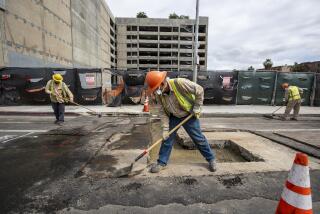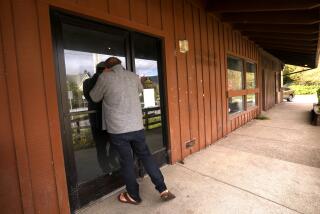Mail Carrier Leaves His Walk of Life After 41 Years
- Share via
Johnny Moreno never wastes a step. He travels his postal route at a pace that would leave many younger people winded and wheezing. Up, up, up he goes--never pausing as he climbs high into the foothills of Santa Paula, a rural town of citrus farms and rambling homes.
“On to the next block,” he says, slinging his 35-pound mailbag over his shoulder and hurrying off.
But Moreno is about to run out of blocks to cover. Come Monday, the 583 customers along mail Route 4 won’t have Moreno dropping by each day. When the elderly fall, when fires start, when a 2-year-old wanders into the road, Moreno won’t be there to help.
After 41 years, Johnny Moreno is finally hanging up his blue uniform, parking his big square truck and retiring.
“I didn’t know that,” 90-year-old Selma Strange said when told her mailman was leaving. “He’s very special. When I go away I leave him a note to hold my mail and he always does. Johnny’s my friend. Who will replace him?”
So far no one has been selected.
The 59-year-old letter carrier has worked longer in the Santa Paula post office than anyone in its history. He has been around so long he can sort mail by name rather than address. He has walked so far his feet have flattened and his shoe size has grown a full inch. And he works the most physically demanding route in the office.
“It’s the ‘trial by fire route.’ I tell other carriers that as bad as it will get for them it won’t get worse than Route 4,” said Richard Garcia, manager of customer service at the Santa Paula post office. “The next person who gets the route will have a legacy to fulfill.”
Santa Paula Postmaster Lena Arista called Moreno the “gold standard” by which other carriers are measured.
Such sentiments seem to embarrass the trim, quiet Moreno.
“It’s not baffling. You park and do the loop. You move the truck another block and do it again,” he said with a slight grin.
Route 4 starts on the valley floor of Santa Paula and slowly winds upward. Narrow side streets, thick with vegetation, hide homes and apartments. Mailboxes can sit atop steep inclines. Addresses get confusing. The route finally emerges at the top of 10th Street, which overlooks a valley of lemon and orange groves in this town of mostly Latino residents.
Moreno began his last day Thursday with an enthusiasm many don’t show on their first.
He parked near McKevett School, grabbed his bag and practically trotted from door to door. Decades spent along the route have made him intimately familiar with the people there. “You can see when people start getting sick,” he said. “They stop coming out. The outgoing mail is in the box. You start getting the sympathy cards.”
Couples who are breaking up are easily spotted. “When you get a forward for ‘Johnny’ but not ‘Susie’ that tells you something’s up,” he said knowingly. “You can also tell when someone has a baby or is getting married.”
Toby Sanchez, 56, lives along Moreno’s route. “He never misses a day,” he said. “He’s always so cheerful and sociable. Rain or shine he’s always here and on time. I worry about who we will get next.”
Moreno waved at a young girl crossing the road. “I coached her softball team,” he said.
A dog yapped ferociously from inside a small house. “That’s Sam,” he said. “I don’t make his day until he gets to bark at me.”
In 41 years he has only been bitten once. “Everyone in this town knows Johnny, even the dogs,” said 52-year-old David Arguellas, standing beside his black Labrador. “He comes right up here and pets the dog and the other mailmen avoid it. He has a dry sense of humor.”
Moreno was born and raised in Santa Paula, where he was a star on the high school football team. He is married with three adult children and is also a great-grandfather. He lives on his route and delivers his own mail.
When he started carrying mail, Santa Paula was a much smaller town, about 16,000 compared with today’s city of about 30,000. The hillsides, now covered in new homes, were still largely empty and green.
In those days there were only two mail trucks. Carriers used their own cars. Bags were lighter, because mail was mostly letters and bills and not pages of inserts and coupons, he said. His salary began at a little over $2 an hour, rising to $21 an hour.
“It’s night and day compared to how it was then,” Moreno said.
Over the years Moreno has done more than give clients their mail. He once found an elderly woman lying in her backyard with a broken elbow. He also alerted the Fire Department when he saw flames rising from a house on his route. In another incident, he grabbed a 2-year-old who was wandering on busy California 150.
He has trained at least 50 letter carriers. “People want this job because they think it’s a kick-back job where you just walk around all day,” Moreno said. “It’s stressful. You have to have a good memory, you have to be organized and you have to be physically capable of doing it.”
Letter carrier Marion Walters has been a co-worker of Moreno’s for 21 years. “The one thing he told me when I started was that my feet would grow one size and after a while they did--from size 8 1/2 to 9 1/2,” Walters said.
Moreno said he doesn’t have any plans for his immediate future.
“I can’t go fishing all the time; I can’t spend all my time in Vegas,” he said while in a rare stationary moment on a hillside. “I love my work. I will probably wake up at 6:30 in the morning and realize I don’t have to go to work anymore. I guess it really hasn’t sunk in yet.”
More to Read
Sign up for Essential California
The most important California stories and recommendations in your inbox every morning.
You may occasionally receive promotional content from the Los Angeles Times.










